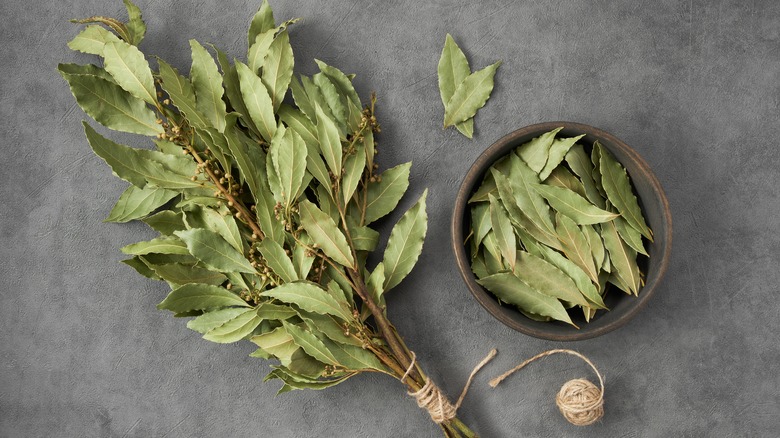Ina Garten Isn't Quite Sold On Bay Leaves
If you're like a lot of home cooks, you've probably asked the same age-old question: Why do we cook with bay leaves? Even the Escoffier School of Culinary Arts says "many people have questions about its necessity and use." According to Britannica, bay leaves come from the sweet bay tree, Laurus nobilis, which is native to the Mediterranean region. The outlet describes bay leaves' profile as "delicately fragrant" with a "bitter taste," containing only 2% essential oils. (Talk about understated.) Food scientist Brian Chau says the flavor is naturally minty with mild eucalyptus notes, via Today, and Escoffier likens the flavor to oregano, thyme, and black tea. But, the fact that recipes only ever seem to call for one singular bay leaf might imply that it's a super potent ingredient to be used in moderation. Still, the sensory experience of opening a package of bay leaves is underwhelming at best.
Believe it or not, another wary bay leaf skeptic is the Barefoot Contessa herself. Ina Garten gives home cooks tools to perfect a hamburger and master stress-free entertaining; She has recommendations for your next Trader Joe's haul and she knows how to elevate your Whiskey Sour, your holiday turkey, and even the PB&J you make as an after-school snack for your kiddo. But, in all of Garten's tips, you'll be hard-pressed to find any mention of bay leaves. Simply put, the chef isn't quite sold.
Mild? Or invisible?
On an episode of "The New Yorker Radio Hour" podcast, Garten was asked, "Are bay leaves B.S.?" It was a compelling question, but Garten's answer was even more compelling. "There are a couple of things that I use bay leaves in and I've always wanted to make them without the bay leaves to see if it made a difference," Garten admitted to the outlet. "And they never have so I'm not sure."
If they aren't in first place already, bay leaves are definitely in the running for the Least Potent Herb in the Spice Cabinet. So, why do home cooks still use them? New York City-based chef and restaurateur Alexandra Shapiro tells Today that the secret to unlocking bay leaves' flavor potential is cooking them in liquid and heat. The longer you allow those bay leaves to cook, the more their natural compounds break down, and the more flavor it'll impart on your dish, Shapiro explains. That's why bay leaves are commonly used in slow-cooked and simmered dishes like soups, stews, sauces, and long-roasted meats. Perhaps the power of this debated herb lies in its mildness. The Escoffier School of Culinary Arts says bay leaves play a "supporting role" that helps emphasize the other spices present in a dish.
Either way, whether you're a born-again believer or a steadfast skeptic, your dish may turn out fine with or without a bay leaf.

